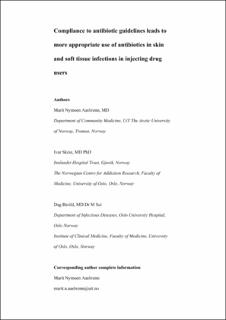| dc.contributor.author | Aasbrenn, Marit Nymoen | |
| dc.contributor.author | Skeie, Ivar | |
| dc.contributor.author | Berild, Dag | |
| dc.date.accessioned | 2020-09-25T11:20:42Z | |
| dc.date.available | 2020-09-25T11:20:42Z | |
| dc.date.created | 2019-07-11T16:45:18Z | |
| dc.date.issued | 2019 | |
| dc.identifier.citation | Infectious Diseases. 2019, 51 (8), 570-577. | en_US |
| dc.identifier.issn | 2374-4235 | |
| dc.identifier.uri | https://hdl.handle.net/11250/2679704 | |
| dc.description.abstract | Background: Knowledge about the treatment of skin and soft tissue infections in injecting drug users in countries with a low prevalence of antibiotic resistance is limited. We investigated bacterial antibiotic resistance and treatment of skin and soft tissue infections in Norwegian drug users. Methods: We performed a two year clinical cross-sectional observational study in a Norwegian hospital. Data were collected retrospectively from hospital records. We examined bacteriological findings and antibiotic resistance, and evaluated compliance to treatment guidelines and appropriateness of empirical antibiotic therapy relative to results of cultures and susceptibility testing. Descriptive and univariate analyses were performed. Results: Hundred and thirty-five injecting drug users were admitted with skin and soft tissue infection in the study period. Cultures were obtained from 103 (77%) abscesses and eight (24%) erysipelas and cellulitis, with bacterial growth in 80 (78%) and five (63%), respectively. Streptococci and staphylococci were the most prevalent bacteria, but methicillin-resistant Staphylococcus aureus was found in only one patient. Compliance to hospital antibiotic guidelines was 70%. Ninety-one per cent of patients in the compliant and 79% in the non-compliant group were given effective empirical antibiotics (p = .334). In the non-compliant group, significantly more patients received broad-spectrum empirical antibiotics (p < .001). In 30 cases where adjustment of antibiotic therapy was possible according to susceptibility testing, this was performed in only 14 cases. Conclusions: Bacteria and resistance patterns did not differ significantly from the skin and soft tissue infections in the general population in Norway. Compliance to antibiotic guidelines led to significantly less use of broad-spectrum antibiotics and to good bacterial coverage. General guidelines for treatment should be applied to injecting drug users with skin and soft tissue infections. | en_US |
| dc.language.iso | eng | en_US |
| dc.publisher | Taylor and Francis | en_US |
| dc.rights | Navngivelse-Ikkekommersiell-DelPåSammeVilkår 4.0 Internasjonal | * |
| dc.rights.uri | http://creativecommons.org/licenses/by-nc-sa/4.0/deed.no | * |
| dc.subject | Skin and soft tissue infections; | en_US |
| dc.subject | abscess; | en_US |
| dc.subject | antibiotics; | en_US |
| dc.subject | compliance to guidelines; | en_US |
| dc.subject | drug users; | en_US |
| dc.subject | people who inject drugs. | en_US |
| dc.title | Compliance to antibiotic guidelines leads to more appropriate use of antibiotics in skin and soft tissue infections in injecting drug users | en_US |
| dc.type | Peer reviewed | en_US |
| dc.type | Journal article | en_US |
| dc.description.version | acceptedVersion | en_US |
| dc.source.pagenumber | 570-577 | en_US |
| dc.source.volume | 51 | en_US |
| dc.source.journal | Infectious Diseases | en_US |
| dc.source.issue | 8 | en_US |
| dc.identifier.doi | 10.1080/23744235.2019.1617435 | |
| dc.identifier.cristin | 1711313 | |
| cristin.ispublished | true | |
| cristin.fulltext | original | |
| cristin.fulltext | postprint | |
| cristin.qualitycode | 1 | |

